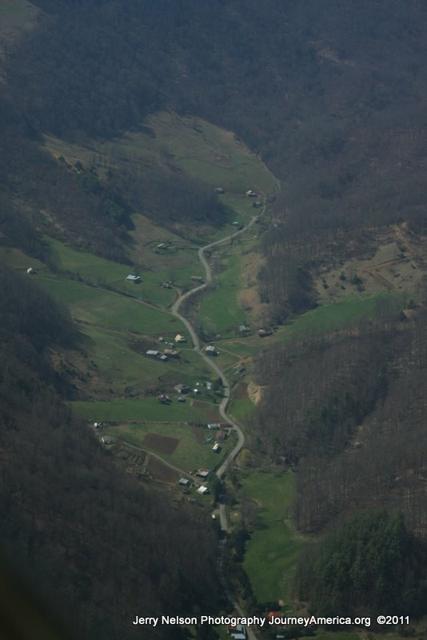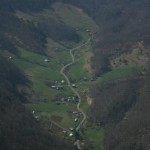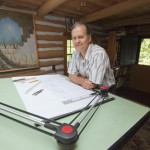- Waste not: In the 1980s, the residents of the Sandy Mush community in north Buncombe County found their peaceful valley was one of several sites proposed by the U.S. Department of Energy for a high-level nuclear waste repository. No repository has been built; high-level waste still awaits a final resting place. Photo by Jerry Nelson; flight courtesy of Southwings.
- Leading the charge: NIRS staffer and Asheville resident Mary Olson is helping area residents engage President Obama’s Blue Ribbon Commission on America’s Nuclear Future, a group of industry and scientific experts charged with plotting the future of our most dangerous nuclear waste. Photo by Jerry Nelson
- Following the document trail: UNCA Adjunct Professor of Environmental Studies Greg Olson collected a host of documents on the history of the DOE search for a nuclear waste repository and its interest in a WNC site. Photo by Jonathan Welch
The imminent release of a report by the Blue Ribbon Commission on America’s Nuclear Future has revived fears of a high-level radioactive-waste repository in Western North Carolina. In the 1980s, local activists fought such a proposal to a standstill; mindful of that, concerned residents are tracking the commission’s activity. Established by President Obama last year, it’s charged with evaluating alternatives and making recommendations for storing, processing and disposing of spent fuel from nuclear power plants and related high-level waste. The draft report is due out July 29 (see box, “Sneak Peek”).
But fears of an imminent WNC waste dump are misplaced, maintains Timothy Frazier of the Department of Energy. “The commission hasn’t been charged to select a site anywhere to do anything,” he reports. “There’s this perception that we’re going to issue a report that says, ‘Put it in Sandy Mush,’ but that’s just not going to happen.”
And in any case, it appears that the transport and incineration of radioactive wastes may constitute more immediate threats to the area.
Waste not
Radioactive material is treated differently depending on how long it must be kept isolated to avoid contaminating water, soil and food supplies. Low-level waste (such as contaminated protective clothing, cleaning equipment, filters and medical material) is typically buried (or incinerated and then buried) at commercially operated facilities approved by the Nuclear Regulatory Commission.
But high-level waste must be kept isolated for tens of thousands of years before it returns to the original level of radioactivity of the ore from which it was produced — and far longer before it ceases to be a health hazard. The favored disposal approach is deep burial at a geologically stable site. To date, however, no nation has managed to surmount the considerable technical and political difficulties to accomplish deep burial, though various countries are said to be developing permanent sites.
Meanwhile, nuclear power plants keep generating highly toxic high-level waste, and the question of what to do with it remains the most controversial aspect of nuclear power, according to the nonprofit Nuclear Information and Resource Service. For decades, waste has been “temporarily” stored in specialized casks and cooling ponds at more than 100 sites across the U.S. Vulnerable to earthquakes, power failures and terrorist attacks, these sites aren’t considered suitable for permanent storage.
As early as 1982, the Nuclear Waste Policy Act envisioned more than one high-level repository; a 1987 revision called for one in the East (where most of the waste is generated) and one in the West (which contains large expanses of arid, sparsely populated land).
In 1986, the DOE released a report on its efforts to find one or more permanent homes for high-level radioactive waste. The so-called “SE5 quadrangle,” a 105-square-mile area including Big Sandy Mush and areas near Canton in north Buncombe County, was one of a dozen places in the eastern U.S. the report identified as a potential deep-burial site.
That same year, the N.C. Geological Survey published the first detailed geologic maps and rock descriptions for the area as the agency looked for the geological features the DOE deemed desirable. The SE5 quadrangle failed to meet federal size and depth criteria, according to Greg Olson, who teaches environmental studies at UNCA; it was also found to possess porous bedrock, creating a risk of widespread ground-water contamination.
Local activists pushed back hard. “Have you been up to Beaverdam Gap over Big Sandy Mush?” queries music producer Steven Heller, who was part of that campaign. “It’s like, ‘Let’s find the prettiest place in the world and destroy it.’ The moon would be a good place” for a high-level waste repository.”
Ultimately, the focus shifted west, to Nevada’s Yucca Mountain. Critics say the site, mandated by Congress, never met the original criteria; and after more than three decades of planning and billions of dollars (much of it paid to utilities because the government failed to open the site as agreed), the proposed facility remains bogged down in a regulatory and litigious quagmire.
The eastern repository, though, was never officially canceled, and in 2008, the DOE told Congress that additional storage capacity will be needed.
Keep on truckin’
Even without a local storage site, however, large amounts of high-level waste could end up being transported through the Asheville area en route to the Savannah River Site in South Carolina, local activists note.
The DOE’s 310-square-mile “nuclear reservation” already contains decommissioned reactors as well as facilities producing material for nuclear weapons. But influential community members want to expand the site’s mission to include reprocessing spent fuel from nuclear power plants to extract weapons-grade plutonium.
Supporters of the idea include “everyone from Sen. Lindsey Graham down to community-college leaders determined to train the next generation of nuclear workers,” says Mary Olson (no relation to Greg Olson) of the nonprofit Nuclear Information and Resource Service. And if they get their way, the Asheville resident asserts, “We could see thousands of trucks with nuclear waste traveling on I-40, I-26 and I-240.”
Already, says the Asheville-based group Common Sense at the Nuclear Crossroads, trucks carrying mostly low-level radioactive material routinely travel through Asheville on their way to the Savannah River Site or other processing facilities in the region.
“We may one day see casks of spent fuel, the most highly radioactive stuff of all, headed west through Biltmore Village on the Norfolk Southern line,” Asheville-based investigative journalist Michael Hopping wrote in a 2006 report for The Indie. “Given our mountainous terrain and a pair of prime accident locations — the Smokey Park Bridge and the junction of I-40 and I-26 — it seems reasonable to ask how prepared we are for serious mishaps involving these shipments.”
Blowin’ in the wind
In the meantime, the Nuclear Regulatory Commission recently approved licenses for importing 1,000 tons of low-level radioactive waste from Germany for incineration in Oak Ridge, Tenn.
EnergySolutions, a Utah-based multinational corporation, operates a disposal facility there. Tennessee receives 75 percent of the nation's low-level radioactive waste — some 41 million pounds per year, the Associated Press reports.
Incineration is monitored to meet state air-quality rules, says Tisha Calabrese of Tennessee’s Department of Environment and Conservation. But the health risks are greater with older incinerators, activists note, and the Oak Ridge incinerators have been burning radioactive waste since the late 1980s.
Despite having state-of-the-art equipment, the grass-roots group Nuclear Watch South asserts, Germany wants to ship its waste elsewhere, because that country’s limits on the release of toxic byproducts are much stricter than Tennessee’s.
It’s hard to know what this means for WNC residents. Our prevailing winds come from the west, but the closest monitoring station, in Morganton, runs only 24 hours once a month, according to William Jeffries of the state’s Radiation Protection Section. Jeffries said he was unaware of the German waste deal but would look into it.
Activists, however, worry that Tennessee may now become a global destination for radioactive waste. “EnergySolutions previously applied to import 20,000 tons of Italian nuclear waste to Oak Ridge,” writes blogger Kathleen Ferris of Murfreesboro, Tenn., co-founder of Citizens to ENDIT. “We can probably assume that the Italians will be next. Then who? The Japanese? … Who would stop it?”
— Send your local environmental news and tips to sandrew@mountainx.com, or call 251-1333, ext. 153.







Susan Andrew really went beyond her ability to ratchet up the fear. Out of an endless amount of words backed up by limited sources Susan was able to conjecture up a fearful future filled with tons of nuclear fuel rods. Out of all her words she barely mentioned recycling of old fuel rods a process that would significantly reduce the amount of left over radioactivity. She also did not even mention 4th generations nuclear plants that have already been demonstrated to use all nuclear “waste” fertile and fissionable and leave a non-actinide ceramic by-product that will decay to below background in less than 300 years. Thus there is no more “waste” problem just a short-term storage problem. Be assured one day we will use the vast amounts of energy still left in these fuel rods.
It seems to me Susan is one of those who are dying for attention so instead of using reputable sources and giving a complete picture about an issue she would rather yell murder at the top of her lungs. Honestly I don’t see how half-truths have any place in a discussion as important as our energy future.
Jfarmer9
Thanks for a fine article that touches on the main points of this global & local issue. Sadly, there are still those who believe that high level waste can be “recycled” to reduce the radioactivity – in fact it is merely diluted into a greater volume while extracting the plutonium. Others subscribe to “pie in the sky” predictions of maybe someday nuclear power systems will be safe. Those who swallow these “non-truths” are a part of the problem today, believing blindly in the nuclear industry spin & lobbying efforts. Plus, even if it were safe ( ask the Japanese ), why spend trillions more of the tax payer’s money? The best nuclear power is fusion, and we have one for free – safely – 93 million miles away.
Many Thanks to Susan Andrew, for a thoughtful, well written article, and to MountainXpress for showing concern for the community.
Perhaps Mr.Jfarmer9 could counter with “whole” truths, rather than personal attacks on local journalists.
“Honestly I don’t see how half-truths have any place in a discussion as important as our energy future.” Let’s discuss solar and wind energy, let’s discuss evolving, and sustainable living for everyone.
@everyone who as thus far responded to this article
Wow, that’s great that people want to talk about the entire energy picture. All I can say is what could be better than a little discussion about our future and the future of the generations to come. Well here are the facts, as I know them, correct me if you want but please do so by citing legitimate peer reviewed scientific sources.
Wind and solar are inheritably inefficient, by this I mean that even on the windiest day the most advanced wind mill can only reach 30% of it’s capacity. Basically, the same goes for solar but less so. Lets also remember that as much as we want wind and solar to be on demand/base load power sources they are not. Thus we will never be able power grid with solar and wind at more than 10 or maybe 15 percent unless we want to face the threat of devastating brownouts. Now the numbers that I cited do not include the smart grid but the idea of spending multi billions on a new grid in order to enable us to allow us to reach maybe 25% solar and wind seems like a waste of money.
Now I know what I said sounds like a gloom and doom future especially since we must get the rest of our power from fossil fuels and an aging nuclear fleet but there is another possibility. That possible future which I personally try to promote is world full of 4th generation nuclear reactors. Before I go any further I encourage all to Goggle “Bill Gates Ted Conference TeraWave Reactor.” There you will find a link to a 20-minute presentation that will both encourage and blow your mind about the endless possibilities of this future power sources.
As I noted in an earlier comment generation IV reactors can use all actinides as a fuel source. In plain English this means all left over fuel rods along with an almost endless supply of DU(U238) can be used as a fuel source. The end product will be a ceramic material that will decay to less than normal background radiation in less than 300 years. If I personally was an anti-nuke this is when I would be thinking that everything I heard so far is just another of many endless promises that I have heard from the nuclear industry. Well friendo I am here to tell you this stuff is for real.
The US and Germany have already built functional 4th generation reactors that have done exactly what I have said. Not only that but both reactors ran a test scenario where they eliminated all coolant and personnel and the end result was the reactors shut down without incident. (ie..No possibility of a Fukushima Daiichi incident)
All of what I have said is very cool but what really gets me going about 4th generation reactors is what Bill Gates said about his 4th generation reactor at last years Ted Conference. In essence he said if he can mass-produce his TeraWave reactor he could reduce utility cost by half thus raising billions of humans out of poverty and into the middle class. Honestly, has or will wind and solar ever be able to make such a boast.
Viva the nuclear renaissance,
Jfarmer9
Dear Jfarmer9:
I am responding to you…so I am going to be using your text and will use “” to be clear.
“”That possible future which I personally try to promote is world full of 4th generation nuclear reactors.””
First point: there is a difference between promoting and reporting. Xpress is a news / entertainment publication. Please do not get confused about its role. Reporting is reporting and Susan has done a stellar job. There is nothing wrong with promotion — however thank you for acknowledging that is your goal.
“”Well here are the facts, as I know them, correct me if you want but please do so by citing legitimate peer reviewed scientific sources.””
Jfarmer, you cite one source: Bill Gates.
I think it is entirely appropriate for you to draw on your knowledge — “facts as I know them” — but to then expect all other participants in the discussion to footnote their own knowledge is not appropriate.
At the same time, I really would like your source for this statement about the product of Generation IV reactors: “that will decay to less than normal background radiation in less than 300 years” — if it is Bill’s TED, did he give a source?
It is next to impossible to fission anything with generating radionuclides with very long half-lives — I-129 for instance has a 15.7 million year half life!
I am a biologist. There is no basis for thinking that an activity that generates radioactivity in an on-going way is any safer to the population impacted simply because the wastes may last 300 years (from the last moment of generation) instead of in perpetuity. Radiation that persists for only hours can still cause cancer and birth defects.
“”…she barely mentioned recycling of old fuel rods a process that would significantly reduce the amount of left over radioactivity.””
Recycling? Reprocessing is the recovery of plutonium. Plutonium is about 1% in the waste from reactors in use today; 99% of the waste remains waste! There are claims that the uranium will be reused, but the mess created from an attempt at that during the cold war will be billions to clean up. Nowhere in the world is uranium from reactor waste actually reused. Stellar reporting on that idea of reusing the uranium was done by Joby Warrick at the Washington Post:
There is zero reduction in radioactivity — although it is less concentrated (which means the same amount of radioactivity is occupying a much larger volume). By the way, all plutonium is weapons usable. I agree with you that we need to move away from fear — and one of the best ways to do that will be for the nuclear nations to recognize that putting nuclear-weapons-usable materials into commerce (fuel for power plants that you envision going ALL OVER THE WORLD) is essentially giving everyone a nuclear weapons factory, and is a very very bad idea. That will really reduce the fear factor! A recent presentation by a world expert on reprocessing given to the BRC panel Susan is reporting on is posted:
http://www.ieer.org/reports/ManagingSpentFuel-BRC-2010-slides.pdf
“Wind and solar are inheritably inefficient, by this I mean that even on the windiest day the most advanced wind mill can only reach 30% of it’s capacity. ”
Have you ever studied the fuel efficiency of the steam cycle (coal and nuclear power plants are based on 17th century steam power — James Watt!) — if you have, then you know that only about 30% of the energy in the fuel makes electric power — 70% is released to the environment as thermal pollution due to the need to re-condense the steam to keep the cycle going. Wind and nuclear are just about on the same par.
“”Lets also remember that as much as we want wind and solar to be on demand/base load power sources they are not. “”
Check out the Solar Grand Plan published a few years ago in Scientific American see: http://www.science.smith.edu/~jcardell/Readings/uGrid/Solar_Plan_08.pdf
Solar is going 24 / 7 and will be “baseload” capacity — at least in the areas of highest potential.
“”generation IV reactors can use all actinides as a fuel source””
My big question is why would you? Why would you create more and more deadly, radioactive, potentially nuclear-weapons-usable stuff when we have the biggest, baddest, coolist fission / fusion reactor ever sitting the perfect 93 million miles from here. The problem is that there is a “box” based on our current energy equation that many people who make comparisons about options for our energy future get trapped in. It is completely possible to provide ample power with renewable “intermittent” sources — you simply have to use the element of design to couple generating capacity with places for excess power to go — instead of managing for peak demand, you manage for peak production — which is really the current problem in areas with lots of wind — not shortage of power — but periods of overproduction with nothing to do with it. Couple that production with industrial cold units (warehouse freeze units can be taken 50 degrees colder and then allowed to “coast back up” ) and it becomes viable. 2010 was the year of the historic cross-over when retail solar panels became cheaper per KW of generating capacity than new nuclear reactor construction. See: http://www.ncwarn.org/wp-content/uploads/2010/07/NCW-SolarReport_final1.pdf
THIS IS WONDERFUL NEWS!
I’d like to provide a bit of a clarification to this story. When I attempted to describe for readers the difference between high- and low-level radioactive waste, it could be said that I reinforced an industry description of low-level waste as nothing more harmful than “gloves and booties.” Those things ARE classified as low-level waste, but so are control rods, reactor pressure vessels (2-3 stories tall), steam generators (3-5 stories tall), filters and resins from a reactor’s primary coolant loop, and other items with potentially lethal surface doses of radiation.
At present, high-level waste is very narrowly defined as the spent fuel from a nuclear reactor.
To those believing that nuclear power is safe & affordable, let me say that I defend your right to hold an opinion. But a belief that nuclear power systems are safe & affordable is like believing that the Earth is flat, an opinion not supported by the facts.
If one selectively ignores the facts, anything can be “proven” – I can prove the Earth is flat, for example. Find the most accurate level available (let’s say a high tech laser level used in the building industry )and circumnavigate the globe, whether pole to pole or around the equator, checking for level at regular intervals (let’s say every 100 yards). The device can be adjusted to read level at every point, thus “proving” the Earth is flat. All you have to ignore is the fact that you circumnavigated the planet to get the readings.
People are entitled to believe the Earth is flat, just as they are entitled to believe that nukes are a good idea. HOWEVER, it’s a bad idea for a “Flat Earther” to program GPS satellite coordinates based on those beliefs, just as those who swallow the corporate nuclear industry lies of a “nuclear resurrection” should not be driving energy policies.
Congress is currently proposing about 600 billion more tax payer dollars over the next 10 years for the collective nuclear industry (weapons & power). It’s my opinion, based on the economic facts, that we ought to spend only 10% of that money – not on new nukes, but on education. God knows, the American public needs education. What ever happened to the idea of an informed electorate?